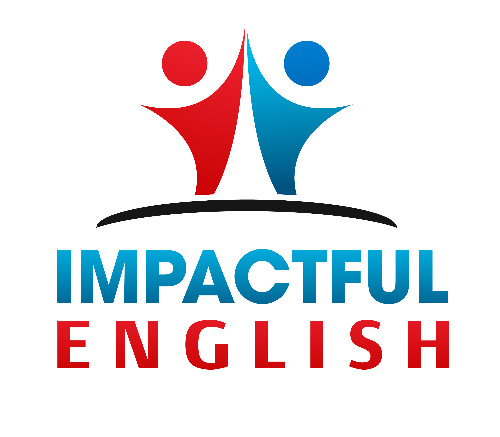

52 Phrases for Better Flowing English Presentations
/ Steven Hobson / Business English , English Presentations , Vocabulary

Do you give English presentations at work, but feel that you could communicate your message in a more objective, fluid way?
Maybe you have an English presentation coming up and want to make sure that your speech is clear and structured so that your audience doesn’t lose concentration and stays with you all the way to the end.
A technique that can help you achieve objective, clear, and structured English presentations, is to use linking phrases that join the separate parts of your presentation together.
English presentations normally consist of an introduction, the main body, individual parts of the main body, and the ending or conclusion.
To help maintain your audience’s attention, you need to signal when you are going from one part to another.
In this article, I teach you 52 phrases that do exactly this – linking the different parts together, and therefore, making your presentation flow better. You’ll find that these phrases will act as ‘signposts’ for the audience when you finish one part and start another.
52 Phrases to Improve the Flow of Your English Presentations
The introduction.
All good presentations start with a strong introduction.
There are a number of different ways you can begin your English presentation. Here’s a simple, but effective introduction structure which works for most types of business presentations:
Introduce – Introduce yourself and greet your audience. Introduce the presentation topic – Explain the reasons for listening. Outline – Describe the main parts of the presentation. Question policy – Make it clear to your audience when they can ask questions: during or at the end?
Here are some phrases which you can use to structure the introduction in this way:
1. Good morning/afternoon (everyone) (ladies and gentlemen). 2. It’s a pleasure to welcome (the President) here. 3. I’m … (the Director of …)
Introduce the presentation topic
4. By the end of the talk/presentation/session, you’ll know how to… / …you will have learned about… / 5. I plan to say a few words about… 6. I’m going to talk about… 7. The subject of my talk is…
8. My talk will be in (three parts). 9. In the first part… 10. Then in the second part… 11. Finally, I’ll go on to talk about…
Question Policy
12. Please interrupt if you have any questions. 13. After my talk, there will be time for a discussion and any questions.

Main Body
Now that you have finished the introduction, we now need to transition to the main body, and its individual parts in a smooth way.
There are three parts of the main body of a presentation where linking phrases can be used:
Beginning the Main Body Ending Parts within the Main Body Beginning a New Part
Here are some phrases which you can use for these parts:
Beginning the Main Body
14. Now let’s move to / turn to the first part of my talk which is about… 15. So, first… 16. To begin with…
Ending Parts within the Main Body
17. That completes/concludes… 18. That’s all (I want to say for now) on… 19. Ok, I’ve explained how…
Beginning a New Part
20. Let’s move to (the next part which is)… 21. So now we come to the next point, which is… 22. Now I want to describe… 23. Let’s turn to the next issue… 24. I’d now like to change direction and talk about…
Listing and Sequencing
If you need to talk about goals, challenges, and strategies in your English presentation, listing phrases can help link these together and improve the flow of your speech. If you have to explain processes, sequencing phrases are helpful:
25. There are three things to consider. First… Second… Third… 26. There are two kinds of… The first is… The second is… 27. We can see four advantages and two disadvantages. First, advantages… 28. One is… Another is… A third advantage is… Finally…
29. There are (four) different stages to the process. 30. First / then / next / after that / then (x) / after x there’s y. 31. There are two steps involved. The first step is… The second step is… 32. There are four stages to the project. 33. At the beginning, later, then, finally… 34. I’ll describe the development of the idea. First the background, then the present situation, and then the prospect for the future.
After you have presented the main body of your English presentation, you will want to end it smoothly.
Here are typical sections transitioning from the main body to the ending of the presentation, and then inviting the audience to ask questions:
Ending the Main Body Beginning the Summary and/or Conclusion Concluding An Ending Phrase Inviting Questions and/or Introducing Discussion Thanking the Audience
Ending the Main Body
35. Okay, that ends (the third part of) my talk. 36. That’s all I want to say for now on (the 2017 results).
Beginning the Summary and/or Conclusion
37. To sum up… 38. Ok, in brief, there are several advantages and disadvantages. 39. To conclude… 40. I’d like to end by emphasizing the main points. 41. I’d like to end with a summary of the main points.
42. I think we have seen that we should… 43. In my opinion, we should… 44. I recommend/suggest that we… 45. There are three reasons why I recommend this. First, … / Second, … / Finally,…
An Ending Phrase
46. Well, I’ve covered the points that I needed to present today. 47. That sums up (my description of the new model). 48. That concludes my talk for today.
Inviting Questions and/or Introducing Discussion
49. Now we have (half an hour) for questions and discussion. 50. So, now I’d be very interested to hear your comments.
Thanking the Audience
51. I’d like to thank you for listening to my presentation. 52. Thank you for listening / your attention. / Many thanks for coming.
Linking phrases are like the skeleton which holds your presentation together.
Not only do they improve the flow and help guide the audience, but by memorizing them they can also help you remember the general structure of your presentation, giving you increased confidence.
To help you memorize, I recommend saying the linking phrases on their own from the beginning to the end of your presentation while you practice.
I also suggest memorizing the introduction word for word. By doing this, you will get off to a great start, which will settle your nerves and transmit a positive first impression.

Whenever you’re ready, there are 3 ways I can help you:
1. The Impactful English Academy : Join like-minded professionals from around the world in The Impactful English Academy. The comprehensive online courses will teach you the system and strategies I have used to help 100’s of professionals speak English more fluently, confidently and professionally. Click here to learn more.
2. One-to -one Coaching : Get access to my guidance and a customised program that has helped, managers, directors, CEO’s, doctors and Government officials worldwide transform into confident and articulate communicators in English. Click here to book a Discovery session with me.
3. Onsite and Online Company Training: Equip your team with the essential communication skills they need to thrive in today’s global marketplace. My tailored onsite and online training programs empower professionals to communicate effectively and confidently in English in international business environments. C lick here to schedule a meeting with me.
Author: Steven Hobson
Steven is a business English coach, a certified life coach, writer, and entrepreneur. He helps international professionals build confidence and improve fluency speaking English in a business environment.
Related posts

A Proven Way to Negotiate More Confidently in English

You Don’t Need Perfect English to Speak with Confidence

4 Proven Actions to Speak Up More in English Meetings
- Facebook Profile
Learning English with Oxford
The latest language learning tips, resources, and content from oxford university press., useful phrases for giving a presentation in english.
- by Oxford University Press ELT
- Posted on April 21, 2023 February 2, 2024

Giving a presentation in English can be challenging, but with these helpful phrases, you can feel confident and ready to make a good presentation in English.
Starting your presentation
So how to start a presentation in English? Begin by saying hello and welcoming everyone. You can also thank the audience for being there with you.
The beginning of the presentation is one of the most important parts because you need to make sure your audience is interested from the start.
You could tell a short story, give a fact, or simply tell the audience a little bit about yourself, e.g. ‘ Let me start by telling you a little bit about myself …’
Then, introduce what your presentation is about by giving an opening statement or an overview of your session. For example, ‘Today, I am going to talk to you about …’ or, ‘Today, we’ll be looking at/focusing on …’.
You can also tell the audience, ‘ If you have any questions, please raise your hand and I’ll be happy to answer them’ … or ‘ We’ll have time at the end for questions.’
Presenting the topic
When you get into the main part of giving your presentation in English, remember that what you’re saying to your audience is new information. Speak slowly, organise your ideas, and make sure your pronunciation is clear. You can learn more about boosting your pronunciation here .
Use expressions to order your ideas and introduce new ones. You can use words and phrases to sequence like, firstly/first of all, secondly, then, next, following this, and lastly/finally.
If you want to introduce the opposite point of view, you can use language like however, on the other hand, contrary to this and then again.
It’s a good idea to link what you are saying back to previous things you have said. This shows you have a well-organised presentation and also helps keep people engaged. For example, ‘as I said previously/at the beginning …’, ‘as you may remember’ and ‘this relates to what I said about ….’
Highlighting information during your talk
When you are giving a presentation in English, you might want to highlight a particular piece of information or something that’s important. You can use phrases such as ‘Let’s focus on …’, ‘I want to highlight …’, ‘Pay attention to …’, ‘Let’s look at …’, ‘I want to briefly address …’, or ‘Now, let’s discuss ….’ You can use these phrases after your sequencing words to help you with your structure.
You can also highlight information by asking your audience their opinion of what you are saying or having them engage with the presentation in some way. For example, you could ask a question and have the audience raise their hands if they agree, or disagree, or if you want to find out how many of them have experience with the situation you’re discussing. Asking questions is a good way to make sure you still have the audience’s attention after you’ve been speaking for a while.
You can also highlight information on your visuals if you’re using them. Use bright, impactful pictures and colours, and don’t include too much writing on your slides.
Finalising the talk
At the end of the presentation, you should summarise your talk and remind the audience of the things you have discussed, and the new information you have given them. You can say things like ‘In summary, we have looked at …’, ‘I’d like to finish by …’, and ‘We’re coming to the end of the presentation. We’ve discussed …’.
You can then ask the audience for any questions you haven’t already answered.
What are your experiences of giving a presentation in English? Do you have any other tips to add? Share below!
Billie Jago is an ELT writer and teacher trainer, specialising in digital & assessments. She is the founder of the professional development podcast ELTcpd and co-founder of the digital ELT content agency, otterelt .
Share this:
Author: Oxford University Press ELT
Every year we help millions of people around the world to learn English. As a department of the University of Oxford, we further the University’s objective of excellence in education by publishing proven and tested language learning books, eBooks, learning materials, and educational technologies. View all posts by Oxford University Press ELT
before You start your presentation ,try please to mention the time duration . sometimes people should be informed so that we can take a coffe break or cigarettes break in order to make evry one happy with the topics
Here is the tip I would add according to my experience :
end your presentation on a positive note, for example with a funny sentence /image /meme / an inspirational quote, in short something that will make your talk pleasant to remember.
Valentina T.
You need to chill out and show calmness and confidence. You should rehearse your presentation on the stage some time before its previously stated time.
Clear, cogent & commanding. Thanks.
I think to get better respond to presentation you can do some mistakes in it and then explain it the end or in the next presentation. Because if anyone would like to learn something also should show involvement.
Leave a Reply Cancel reply
Discover more from learning english with oxford.
Subscribe now to keep reading and get access to the full archive.
Type your email…
Continue reading
Vocabulary and Phrases for Making Presentations in English
Here’s a step-by-step guide for making presentations in English. You’ll find the phrases you need for each step of your presentation.
After you give your opening statement, give a brief overview of your presentation. Say what your presentation is about, how long you will take and how you are going to handle questions.
For example, a presentation to sales staff could start like this: “Welcome / “Hello everyone.”
(Opening statement) “As you all know, this company is losing its market share. But we are being asked to increase sales by 20 – 25%. How can we possibly increase sales in a shrinking market?”
(Overview) “Today I am going to talk to you about how we can do this. My presentation will be in three parts. Firstly I am going to look at the market and the background. Then I am going to talk to you about our new products and how they fit in. Finally, I’m going to examine some selling strategies that will help us increase our sales by 20%. The presentation will probably take around 20 minutes. There will be time for questions at the end of my talk.”
Useful language for overviews
“My presentation is in three parts.” “My presentation is divided into three main sections.” “Firstly, secondly, thirdly, finally…” “I’m going to… take a look at… talk about… examine… tell you something about the background… give you some facts and figures… fill you in on the history of… concentrate on… limit myself to the question of…
“Please feel free to interrupt me if you have questions.” “There will be time for questions at the end of the presentation.” “I’d be grateful if you could ask your questions after the presentation.”
The main body of the presentation
During your presentation, it’s a good idea to occasionally remind your audience why your presentation and ideas are important or relevant.
“As I said at the beginning…” “This, of course, will help you (to achieve the 20% increase).” “As you remember, we are concerned with…” “This ties in with my original statement…” “This relates directly to the question I put to you before…”
Keeping your audience with you
Remember that what you are saying is new to your audience. You are clear about the structure of your talk, but let your audience know when you are moving on to a new point. You can do this by saying something like “right”, or “OK”. You can also use some of the following expressions:
“I’d now like to move on to…” “I’d like to turn to…” “That’s all I have to say about…” “Now I’d like to look at…” “This leads me to my next point…”
If you are using index cards, putting the link on the cards will help you remember to keep the audience with you. In addition, by glancing at your index cards you will be pausing – this will also help your audience to realise that you are moving on to something new.
Phrases for introducing visuals
It’s important to introduce your visual to the audience. You can use the following phrases:
“This graph shows you…” “Take a look at this…” “If you look at this, you will see…” “I’d like you to look at this…” “This chart illustrates the figures…” “This graph gives you a break down of…”
Give your audience enough time to absorb the information on the visual. Pause to allow them to look at the information and then explain why the visual is important:
“As you can see…” “This clearly shows …” “From this, we can understand how / why…” “This area of the chart is interesting…”
Summarising
At the end of your presentation, you should summarise your talk and remind the audience of what you have told them:
“That brings me to the end of my presentation. I’ve talked about…” “Well, that’s about it for now. We’ve covered…” “So, that was our marketing strategy. In brief, we…” “To summarise, I…”
Relate the end of your presentation to your opening statement:
“So I hope that you’re a little clearer on how we can achieve sales growth of 20%.” “To return to the original question, we can achieve…” “So just to round the talk off, I want to go back to the beginning when I asked you…” “I hope that my presentation today will help you with what I said at the beginning…”
Handling questions
Thank the audience for their attention and invite questions.
“Thank you for listening – and now if there are any questions, I would be pleased to answer them.” “That brings me to the end of my presentation. Thank you for your attention. I’d be glad to answer any questions you might have.”
It’s useful to re-word the question, as you can check that you have understood the question and you can give yourself some time to think of an answer. By asking the question again you also make sure that other people in the audience understand the question.
“Thank you. So you would like further clarification on our strategy?” “That’s an interesting question. How are we going to get voluntary redundancy?” “Thank you for asking. What is our plan for next year?”
After you have answered your question, check that the person who asked you is happy with the answer.
“Does this answer your question?” “Do you follow what I am saying?” “I hope this explains the situation for you.” “I hope this was what you wanted to hear!”
If you don’t know the answer to a question, say you don’t know. It’s better to admit to not knowing something than to guess and maybe get it wrong. You can say something like:
“That’s an interesting question. I don’t actually know off the top of my head, but I’ll try to get back to you later with an answer.” “I’m afraid I’m unable to answer that at the moment. Perhaps I can get back to you later.” “Good question. I really don’t know! What do you think?” “That’s a very good question. However, we don’t have any figures on that, so I can’t give you an accurate answer.” “Unfortunately, I’m not the best person to answer that.”
What to say if things go wrong during your presentation
You think you’ve lost your audience? Rephrase what you have said:
“Let me just say that in another way.” “Perhaps I can rephrase that.” “Put another way, this means…” “What I mean to say is…”
Can’t remember the word?
If it’s a difficult word for you – one that you often forget, or one that you have difficulty pronouncing – you should write it on your index card. Pause briefly, look down at your index card and say the word.
Using your voice when making presentations
Don’t speak in a flat monotone – this will bore your audience. By varying your speed and tone, you will be able to keep your audience’s attention. Practise emphasising key words and pause in the right places – usually in between ideas in a sentence. For example “The first strategy involves getting to know our market (pause) and finding out what they want. (pause) Customer surveys (pause) as well as staff training (pause) will help us do this.”
Don’t forget – if you speak too fast you will lose your audience!
Making Presentations
Your answer:
Correct answer:
Your Answers
Blog > English Presentation Structure (Introduction, Closing) & useful Phrases
English Presentation Structure (Introduction, Closing) & useful Phrases
02.21.20 • #powerpoint #presentation #english.
When giving a presentation in english, there are certain guidelines you should follow. Maybe you haven't got a lot of experience presenting - or you would simply like to refresh your already existing knowledge - we're here to teach you the basics about presenting and provide you with a free list of useful phrases and the basic structure you can in your presentation!

1. Structure
The general structure of a presentation is the following:
- Introduction
It is up to you to design these three parts. Using videos or everyday-examples can be a great way to introduce the audience to the topic. The important thing is that you capture the audience's attention from the beginning by making an interesting introduction. The main part is where you present your topic, ideally divided into sections. You can be creative with it - incorporate images, videos, stories or interactive polls . We generally recommend using different kinds of elements, as that makes the presentation more lively. Make sure your main part is well structured, so your audience can follow. In the conclusion, you should give a short summary of the points you made without adding any new information. You can also make an appeal to your audience in the end.
2. Useful Phrases
Here you'll find several phrases that you'll need in every presentation. Of course, you should adapt them and use them in a context that is suitable for your setting. The phrases are divided into subcategories so you can find what you're looking for more easily.

Starting your Presentation
In your introduction, you should:
Welcome your audience
Good morning/afternoon/evening everyone!
Ladies and gentlemen, I welcome you to my presentation about...
Introduce yourself
I am ... (from company ...) and today I would like to introduce you to the topic of ...
My name is ... and I am going to talk about ... today.
Icebreakers (for audience engagement)
Icebreaker polls are an amazing way to engage your audience instantly. They function as a fun and playful element at the beginning, giving you the perfect start you need to give a successful presentation. Click here to read our detailed post about icebreaker polls!
Mention the presentation topic and the reason for giving the presentation
I am grateful to be here today and tell you you about...
I would like to take this opportunity to talk about ...
I am here today to talk to you about ...
The reason why I am here today to talk about ... is ...
The purpose of this presentation is to ...
My goal today is to ...
Hopefully, by the end of the presentation, you will all know more about ...
Give a short overview of the content
To make it as understandable as possible, I divided my presentation into ... parts. In the first part, I will concentrate on ..., the second part will be about ..., ...
First of all, I will give you a short introduction, then we will move on to ...
... and finally, I will give you some insights to ...

Here are a few phrases that you could use during the whole presentation, but especially in the main part.
Engage your audience
In order to raise the audience's attention and improve their engagement, it is extremely important to make contact with them. A great way to do so is by adding interactive elements such as polls. If you would like to know more about this topic, read our article on How To Boost Audience Engagement . You can also use a software like SlideLizard , which allows you to conduct live polls, do Q&A sessions with your audience, share your resources and many more benefits that take your presentation to the next level.
Please raise your hand if you ...
Have you ever thought about ... ?
I would like to do a poll about ...
Please ask any questions as soon as they arrive.
On one hand, … on the other hand…
Comparing … with …, we can see that…
Clearly, … makes more sense than …
Whereas Option A is …, Option B is …
Making new points
Firstly,… Secondly,…
What also has to be mentioned is…
Next, I would like to bring up the topic of…
That being said, now we are going to take a look at…
Let's move on to the next topic.
On the next slide,…
The last thing I would like to mention is…

We made a whole blog post about how to pose questions in your presentation: The Right Way to do a Question Slide .
Talking about images or videos
In this image you can clearly see that ...
We are now going to take a look at a picture/video of ...
I'm going to show you a video by ... about ... now.
I've prepared a video about ...
Talking about statistics and charts
I am now addressing this graph that refers to the results of study XY.
In the graph on this slide, you can see that ...
The average is at ...
This graph clearly shows that the majority ...
According to this graph, the focus should be on ...
What that study tells us for practice is that we should ...
Emphasizing
I would like to emphasize the importance of ...
Moreover, it has to be said that ...
I want to stress the importance of ...
We always have to remember that ...
This is of high significance because ...
That part is especially important because ...
When something goes wrong
I am sorry, but it seems like the projector isn't working.
Could someone please help me with ...?
Is anybody here who knows how to ...?
Could someone give me a hand with ...
I would like to apologize for ...
I apologize for the technical problems, we are going to continue in a minute.
I am sorry for the inconvenience.
End of Presentation
In the conclusion, you should...
Sum up the main points
In conclusion I can say that…
To sum up the main points,…
With all mentioned aspects taken into consideration, I can say that…
Make an appeal
So please, in the future, try to be conscious about...
Please take a moment to think about...
I would like to encourage you to...
Thank your audience and say goodbye
It was a pleasure being here today.
Thank you for listening and goodbye.
Thank you for being such a great, engaged audience. Goodbye.
Thank you so much for listening, see you next time.
What is the structure of a presentation?
Your presentations should always have an Introduction, a Main part and a Conclusion.
What is a good way to begin a presentation?
You can start by introducing yourself, giving an overview of your topic, telling a little story or showing the audience an introductory video or image.
What are good phrases to use in English presentations?
There are many phrases that will make your presentation a lot more professional. Our blog post gives you a detailed overview.
Related articles
About the author.

Pia Lehner-Mittermaier
Pia works in Marketing as a graphic designer and writer at SlideLizard. She uses her vivid imagination and creativity to produce good content.
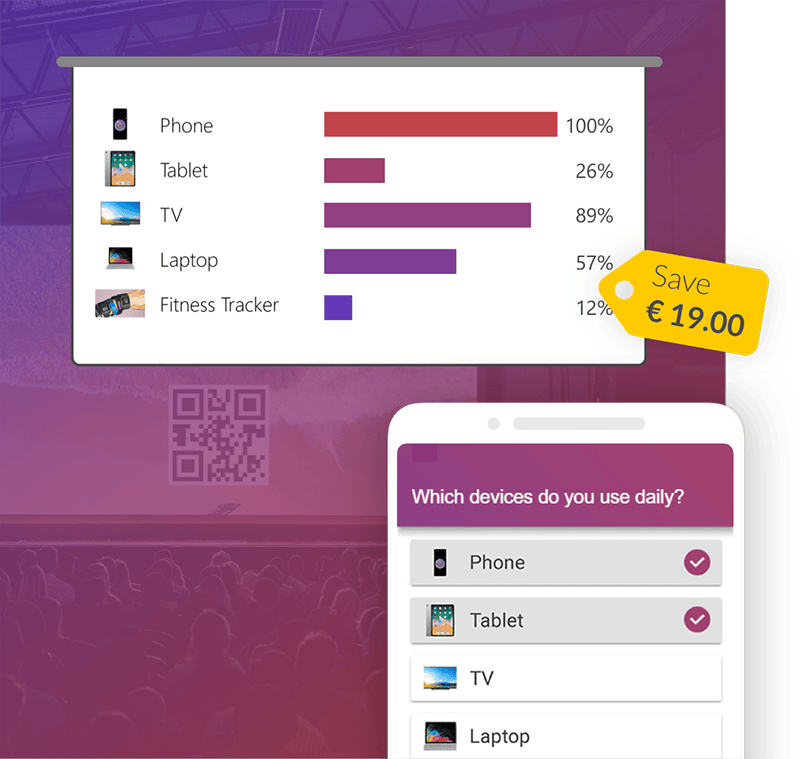
Get 1 Month for free!
Do you want to make your presentations more interactive.
With SlideLizard you can engage your audience with live polls, questions and feedback . Directly within your PowerPoint Presentation. Learn more

Top blog articles More posts

How To Make an interactive Quiz in PowerPoint - Tutorial

All about notes in PowerPoint Presentations
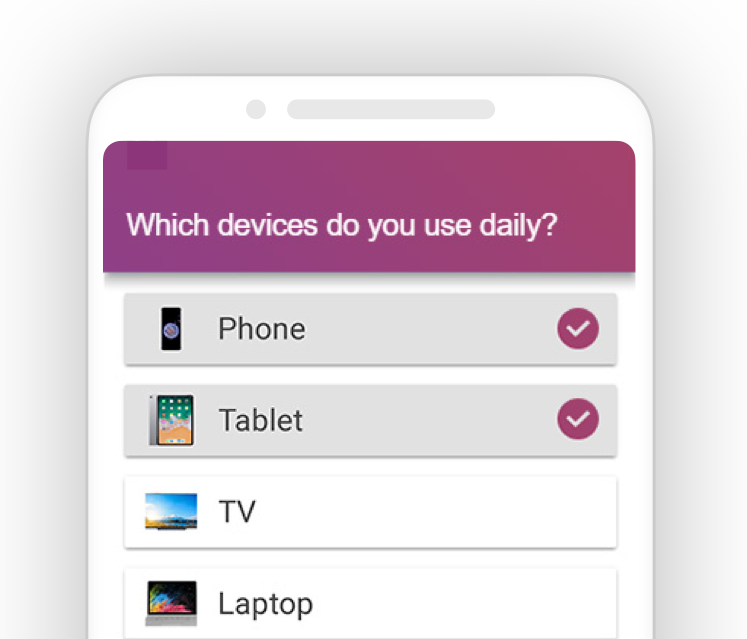
Get started with Live Polls, Q&A and slides
for your PowerPoint Presentations
The big SlideLizard presentation glossary
Visual communication.
If there are used images or videos for communication, it is visual communication. Visual Communication is almost used everywhere like on television, posts on social media (Instagram, Facebook), advertisement.
To interview somebody means to ask a person different questions. An interview is often done by journalists.
Effect Options
In the effect options in PowerPoint, further details can be specified for the selected effect.
Horizontal Communication
Horizontal communication is the exchange of information between people, departments or units within the same level of an organisational hierarchy of a company.
Be the first to know!
The latest SlideLizard news, articles, and resources, sent straight to your inbox.
- or follow us on -
We use cookies to personalize content and analyze traffic to our website. You can choose to accept only cookies that are necessary for the website to function or to also allow tracking cookies. For more information, please see our privacy policy .
Cookie Settings
Necessary cookies are required for the proper functioning of the website. These cookies ensure basic functionalities and security features of the website.
Analytical cookies are used to understand how visitors interact with the website. These cookies help provide information about the number of visitors, etc.
37 Useful Phrases For Presentations In English
- Post author: Harry
- Post last modified: 07/02/2024
- Post category: Business English Vocabulary
- Reading time: 10 mins read
Here you will learn at least 37 useful phrases for presentations in English. Improve your business English skills and feel confident when making presentations in English.
Presentation phrases for setting the scene, recapping, ending a presentation in English and more.
Listen to the podcast Speak Better English with Harry or watch it on YouTube at Learn English with Harry .
List of phrases for presentations in English
useful phrases for presentations in English
Hi there, this is teacher Harry, and welcome back to my English lessons where I try to help you to get a better understanding of the English language.
Okay, so what are we going to cover in the lesson today? Well, all of us, myself included, have to make presentations, from time to time to staff or to bosses, or to clients or customers, whoever it may be. And if you’re using English, not as your native language, then it can be a bit of a challenge. You might feel lacking in confidence. You might feel that you’re not up to the other guys.
But you can do it.
So I’m going to give you some useful phrases that you can use in relation to presentations.

give a gift of learning Offer up to 50% off
Great way to improve your English. Use code LOVE24

setting the scene
You might just simply say at the presentation particularly if it’s online,
- It’s good to see you all here.
- It’s great that you could join me.
- I’m very pleased to be here.
- I’m very pleased to be talking to you today.
- I’m very pleased to be presenting to you today.
- I’m glad you could all make it.
- Thank you all for coming.
- Thank you all for joining in.
- Thank you all for coming together on Zoom.
Whatever it might be, you can adjust the words to suit the media and the medium by which you’re presenting to your guests. Staff, colleagues, clients.
common phrases for starting off presentations
And then if we talk about other useful expressions and phrases.
It’s a good idea to spend 30 seconds introducing yourself.
So my name is Harry, I work in this department, I’d like to talk to you today about…
- The topic of my presentation today is….
- I’m planning to tell you about today….
- I’d like to introduce you to….
So in those sorts of expressions, you’re setting the scene again, you’re telling them exactly what you’re going to cover. And that’s a really good idea in a presentation because then everybody knows what’s going to be spoken about.
My name is Harry, I work in the marketing department. My presentation today is about a new product. The presentation is probably going to take about 20 minutes. And if you have any questions, then please ask them as we go through the presentation.
book your trial English Lesson
Introducing a talk.
Now, if you want to introduce the talk, you could say:
- What I’d like to do in this presentation is…
- First of all, I’ll give you a brief overview of…
A brief overview of the product, a brief overview of the background, a brief overview of our plans.
- Okay, then I’ll talk about….
- And after that, I’d like to show you some market research.
- After that, I’d like to show you our projections.
- After that, I’d like to show you this specific plan for the launching of this product.
So you go step by step by step.
referring to visuals
So in any presentation, visuals are really important, and they can help you.
And they can also support you if you’re a little bit lacking in confidence about the presentation itself.
And you perhaps don’t want to be the focus of everything.
So the type of phrases you might use in that context would be something like:
- You will notice on this chart…
- If you look at this slide, we can see…
- Have a look at these figures…
As I said, it helps you, it supports you and enables you to just sort of hide a little bit behind those slides that focus on the screen, not specifically on you.
Useful Phrases For Presentations In English
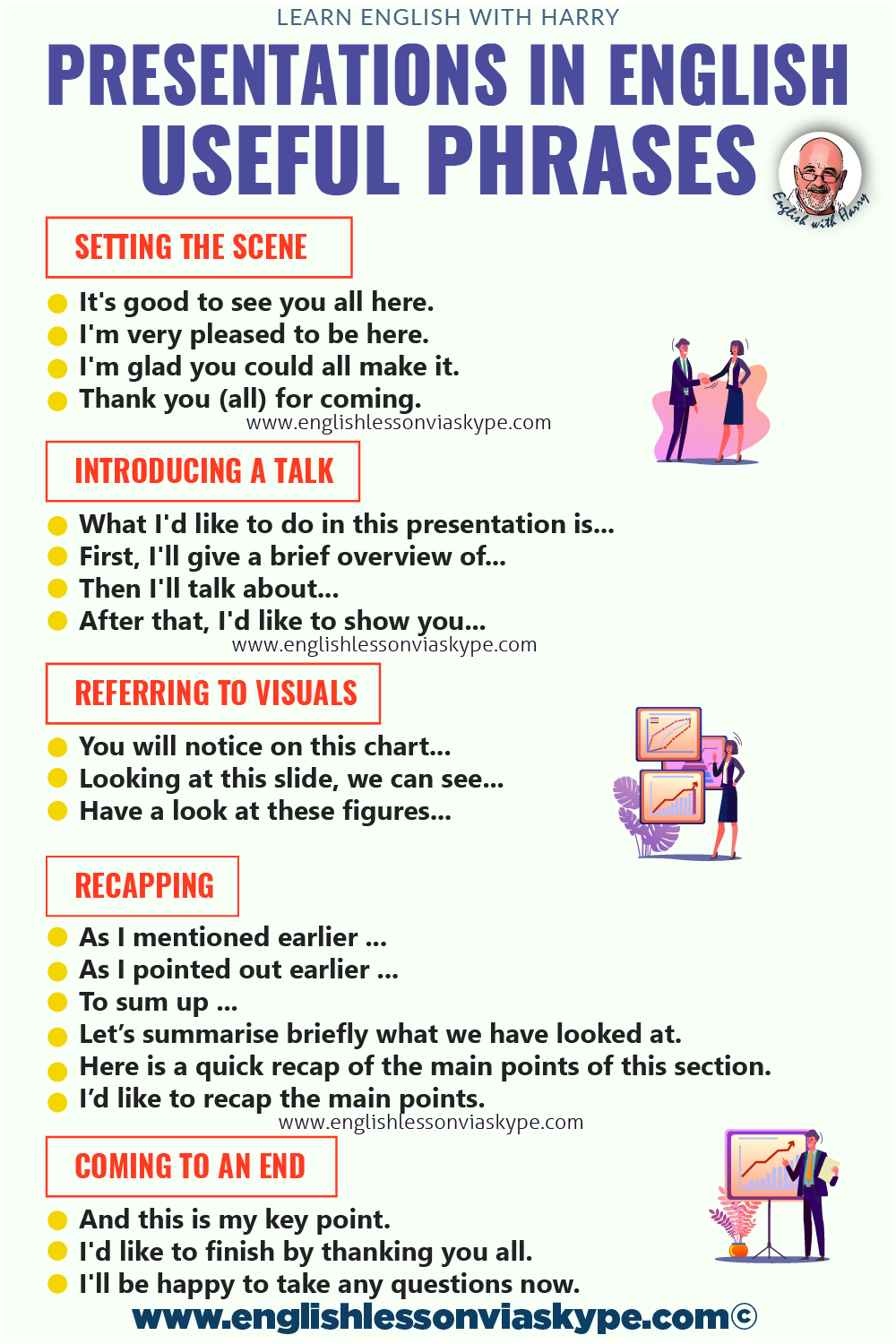
Share and help other students to improve English language skills.
Finishing off a section.
And when you want to finish off in relation to those sort of aspects, you might just summarise by saying,
- Well, that’s all I wanted to say on that particular topic.
- If you’ve got any questions, I’d be happy to take them now.
- To summarise what I said is…
- If you want to contact me offline, just send me an email.
- As I promised, I’ve now finished the presentation, it only took 20 minutes.
- I appreciate you watching and listening and your attention.
- If I have any questions, I’ll be happy to answer them now.
- Have you any questions?
So again, helpful information directly in them, how they can get in touch with you after your presentation.
speak better English podcast - episode 368
Checking and moving on.
So during the presentation, we want to make sure that the people are listening, but you also don’t want to spend too much time on each particular point.
So you check their understanding so far, and then you move on. So you might say to the people,
- Does that sound okay to you?
- Do you follow that?
- Is it clear?
- Can I clarify anything else?
- If not, let’s move on.
- Let’s look at the next slide.
- Now, let’s move on to the really important topic of…
- Let’s turn to the topic of budgets.
So you pinpoint exactly what you want to cover. When you’re going to cover it and then you move on. So you check that they understand it.
I also find in these types of presentations, particularly if they’re a bit longer than a few short slides, that it’s a good idea to do some recapping.
To recap means to go over what you’ve done before. Not a huge amount of detail because you don’t want to bore them by going through everything, but you recap quite quickly.
- Before I move on…
- I’m going to recap quickly…
- Let me summarise briefly…
- Here’s a quick recap of what we’ve covered today.
- I’d like to recap the main points.
- Let me go over the main points for you once more.
All of those good, acceptable expressions and words that you can use.
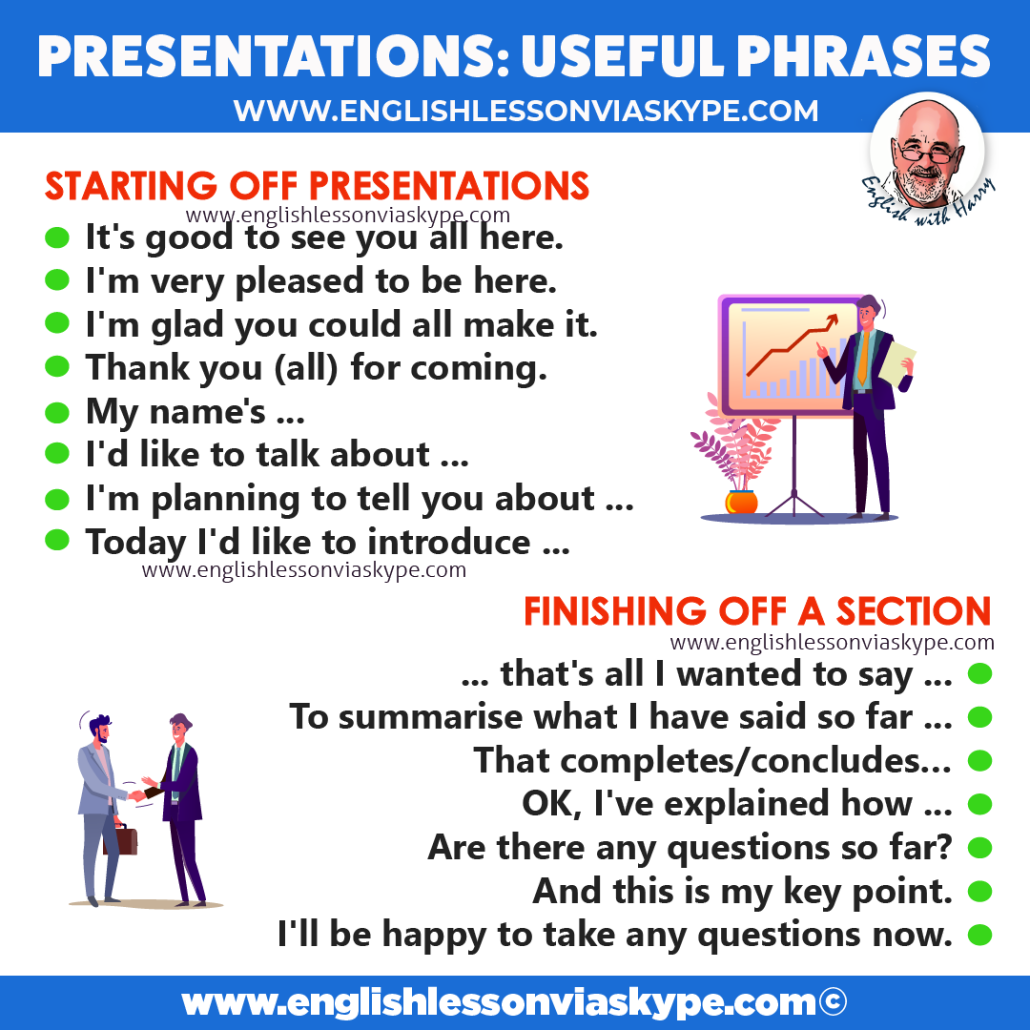
coming to an end
And then when you come to the end of the presentation, you want to sign off, you want to finish them. We can say,
- Well, this is my key point.
- This is the key point in all of this, so let me finish on this.
- This is what I want to say to sum up in a few words.
- I’d like to finish now by thanking you all for your kind attention.
- I look forward to joining you again soon.
- I look forward to any questions.
- I look forward to receiving your emails.
- I’d be happy to take any questions now.
All nice and polite ways of informing people that this is the end.
So there’s somebody out there in the audience who’s asleep, they’ll probably wake up at that point when you say and finally or, in conclusion
Well, hopefully you’ve got something in particular that you can hold onto there. Something that can help you if you’re making presentations in English.
If you have any other queries, come to me, I’m very, very happy to help you. My contact details are www.englishlessonviaskype.com .
And indeed, if you want some help, how to make presentations, if you want some help, how to get through interviews, or you just want general help with your English well, why not try our one-to-one online English lessons .
Thanks for listening. Join me again soon.
More information
For more information on English grammar rules, English collocations and English idioms, check out the links below:
How to learn English vocabulary easily
English idioms about holidays and travel
You can always study English advanced level at Learning English with the BBC and British Council Learn English .
When to use INTO and ONTO in English?
Here you will learn English grammar rules on how to use INTO and ONTO in English. What is the difference
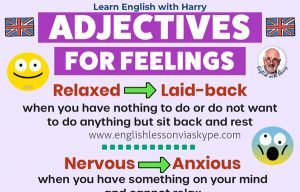
Phrasal Verbs with Over
Here you will learn 12 English phrasal verbs with over. As always, I will give you clear explanations and examples.
enrol in a free course

- Phrasal Verbs + Grammar + Funny English Idioms
online english courses from €7.99
- free english mini course
- english grammar refresher
- 73 most common mistakes
- Advanced english workout 1
- advanced english workout 2
- advanced english workout 3
- job interview in english
- how to teach english online
follow me on social media
Advanced english learning course.
Improve English from intermediate to advanced level in my intensive English course.
55 online lessons + 6 online courses + direct contact with Harry
learn english with us
- zoom/skype english lessons prices
- our teachers
- english learning blog
- Odnoklassniki icon Odnoklassniki
- Facebook Messenger
- LiveJournal
How can I advance my English?
Useful English phrases for a presentation

Presentations have the advantage that many standard phrases can be used at various points. Perhaps you wish to welcome the audience, introduce the speaker and the topic, outline the structure, offer a summary, or deal with questions. In all these situations, you can apply a number of useful expressions that will make your presentation a linguistic success.
At the beginning of each presentation, you should welcome your audience. Depending on who you are addressing, you should extend a more or less formal welcome.
Good morning/afternoon/evening, ladies and gentlemen/everyone.
On behalf of “Company X”, allow me to extend a warm welcome to you.
Hi, everyone. Welcome to “Name of the event”.
Introducing the speaker
The level of formality of your welcome address will also apply to how you introduce yourself. Customize it to match your audience.
Let me briefly introduce myself. My name is “John Miller” and I am delighted to be here today to talk to you about…
First, let me introduce myself. My name is “John Miller” and I am the “Position” of “Company X”.
I’m “John” from “Company Y” and today I’d like to talk to you about…
Introducing the topic
After the welcome address and the introduction of the speaker comes the presentation of the topic. Here are some useful introductory phrases.
Today I am here to talk to you about…
What I am going to talk about today is…
I would like to take this opportunity to talk to you about…
I am delighted to be here today to tell you about…
I want to make you a short presentation about…
I’d like to give you a brief breakdown of…
Explanation of goals
It is always recommended to present the goals of your presentation at the beginning. This will help the audience to understand your objectives.
The purpose of this presentation is…
My objective today is…
After presenting the topic and your objectives, give your listeners an overview of the presentation’s structure. Your audience will then know what to expect in detail.
My talk/presentation is divided into “x” parts.
I’ll start with…/First, I will talk about…/I’ll begin with…
…then I will look at…
and finally…
Starting point
After all this preparation, you can finally get started with the main part of the presentation. The following phrases will help you with that.
Let me start with some general information on…
Let me begin by explaining why/how…
I’d like to give you some background information about…
Before I start, does anyone know…
As you are all aware…
I think everybody has heard about…, but hardly anyone knows a lot about it.
End of a section
If you have completed a chapter or section of your presentation, inform your audience, so that they do not lose their train of thought.
That’s all I have to say about…
We’ve looked at…
So much for…
Interim conclusion
Drawing interim conclusions is of utmost importance in a presentation, particularly at the end of a chapter or section. Without interim conclusions, your audience will quickly forget everything you may have said earlier.
Let’s summarize briefly what we have looked at.
Here is a quick recap of the main points of this section.
I’d like to recap the main points.
Well, that’s about it for this part. We’ve covered…
Use one of the following phrases to move on from one chapter to the next.
I’d now like to move on to the next part…
This leads me to my next point, which is…
Turning our attention now to…
Let’s now turn to…
Frequently, you have to give examples in a presentation. The following phrases are useful in that respect.
For example,…
A good example of this is…
As an illustration,…
To give you an example,…
To illustrate this point…
In a presentation, you may often need to provide more details regarding a certain issue. These expressions will help you to do so.
I’d like to expand on this aspect/problem/point.
Let me elaborate further on…
If you want to link to another point in your presentation, the following phrases may come in handy.
As I said at the beginning,…
This relates to what I was saying earlier…
Let me go back to what I said earlier about…
This ties in with…
Reference to the starting point
In longer presentations, you run the risk that after a while the audience may forget your original topic and objective. Therefore, it makes sense to refer to the starting point from time to time.
I hope that you are a little clearer on how we can…
To return to the original question, we can…
Just to round the talk off, I want to go back to the beginning when I…
I hope that my presentation today will help with what I said at the beginning…
Reference to sources
In a presentation, you frequently have to refer to external sources, such as studies and surveys. Here are some useful phrases for marking these references.
Based on our findings,…
According to our study,…
Our data shows/indicates…
Graphs and images
Presentations are usually full of graphs and images. Use the following phrases to give your audience an understanding of your visuals.
Let me use a graphic to explain this.
I’d like to illustrate this point by showing you…
Let the pictures speak for themselves.
I think the graph perfectly shows how/that…
If you look at this table/bar chart/flow chart/line chart/graph, you can see that…
To ensure that your presentation does not sound monotonous, from time to time you should emphasize certain points. Here are some suggestions.
It should be emphasized that…
I would like to draw your attention to this point…
Another significant point is that…
The significance of this is…
This is important because…
We have to remember that…
At times it might happen that you expressed yourself unclearly and your audience did not understand your point. In such a case, you should paraphrase your argument using simpler language.
In other words,…
To put it more simply,…
What I mean to say is…
So, what I’m saying is….
To put it in another way….
Questions during the presentation
Questions are an integral part of a presentation. These phrases allow you to respond to questions during a presentation.
Does anyone have any questions or comments?
I am happy to answer your questions now.
Please feel free to interrupt me if you have questions.
If you have any questions, please don’t hesitate to ask.
Please stop me if you have any questions.
Do you have any questions before I move on?
If there are no further questions at this point, I’d like to…
Questions at the end of a presentation
To ensure that a presentation is not disrupted by questions, it is advisable to answer questions at the very end. Inform your audience about this by using these phrases.
There will be time for questions at the end of the presentation.
I’ll gladly answer any of your questions at the end.
I’d be grateful if you could ask your questions after the presentation.
After answering a question from the audience, check that the addressee has understood your answer and is satisfied with it.
Does this answer your question?
Did I make myself clear?
I hope this explains the situation for you.
Unknown answer
Occasionally, it may happen that you do not have an answer to a question. That is not necessarily a bad thing. Simply use one of the following phrases to address the fact.
That’s an interesting question. I don’t actually know off the top of my head, but I’ll try to get back to you later with an answer.
I’m afraid I’m unable to answer that at the moment. Perhaps, I can get back to you later.
Good question. I really don’t know! What do you think?
That’s a very good question. However, I don’t have any figures on that, so I can’t give you an accurate answer.
Unfortunately, I’m not the best person to answer that.
Summary and conclusion
At the end of the presentation, you should summarize the important facts once again.
I’d like to conclude by…
In conclusion, let me sum up my main points.
Weighing the pros and cons, I come to the conclusion that…
That brings me to the end of my presentation. Thank you for listening/your attention.
Thank you all for listening. It was a pleasure being here today.
Well, that’s it from me. Thanks very much.
That brings me to the end of my presentation. Thanks for your attention.
Handing over
If you are not the only speaker, you can hand over to somebody else by using one of these phrases.
Now I will pass you over to my colleague ‘Jerry’.
‘Jerry’, the floor is yours.
We hope that our article will help you in preparing and holding your next presentation. It goes without saying that our list is just a small extract from the huge world of expressions and phrases. As always, the Internet is an inexhaustible source of further information. Here are the links to two websites that we would recommend to you in this context.
usingenglish
- What is the difference between American English (AE) and British English (BE)?
Comments are closed.
image sources
- : © Thaut Images
Fast and affordable
Choose the number of words: ?
How many days do we have?
Get to know us first! We can correct a random page from your document completely free of charge and with no obligation from your side.
- Interesting
- Miscellaneous

Elevate Your Presentations: Mastering English Presentation Words and Phrases

The art of delivering a compelling presentation lies in the finesse of your language skills. It’s about crafting resonating sentences, choosing captivating words, and initiating a dialogue that piques curiosity. One must know how to maneuver through this landscape, from setting the scene with a powerful introduction to concluding with a thought-provoking statement. That’s where this guide comes in. It will give you key presentation sentences, phrases, and words to help elevate your communication skills.
Presentation Starting Phrases
In the realm of presentations, first impressions matter tremendously. Your opening words set the stage for the rest of your discourse, establishing the tone and drawing in your audience. The right choice of phrases can create a compelling introduction that commands attention and sparks interest. Here, we will explore a selection of presentation-starting words and phrases to help you set a strong foundation:
- I’d like to start by…
- Today, I’m here to discuss…
- Let’s begin with a look at…
- Good morning/afternoon/evening, my name is…
- It’s a pleasure to be here today to talk about…
- Let’s dive straight into…
- I would like to kick off with…
- Firstly, let’s consider…
- Have you ever wondered about…
- Thank you for joining me as we explore…
- Today’s focus will be on…
- Let’s set the stage by discussing…
- The topic at hand today is…
- To start, let’s examine…
- I want to begin by highlighting…
Crafting an engaging opening with the presentation starting words, is akin to opening the first page of a riveting novel. These phrases serve as a doorway, inviting your audience into the fascinating narrative you are about to share.
Setting the Scene: Key Presentation Phrases
Now that you have your audience’s attention, the next crucial step is to set the scene. It involves using key phrases to keep your audience engaged, clarify, and effectively communicate your main points. A well-set scene guides the audience through your presentation, helping them understand your narrative and easily follow your arguments. Let’s look at some essential phrases that can help you accomplish it:
- Moving on to the next point, we see...
- Delving deeper into this topic, we find...
- An important aspect to consider is...
- It leads us to the question of...
- Another critical point to remember is...
- To illustrate this point, let me share...
- On the other hand, we also have...
- Furthermore, it’s critical to note that...
- Let’s take a moment to examine...
- As an example, let’s look at...
- The evidence suggests that...
- Contrary to popular belief...
- It’s also worth noting that...
- Digging into this further, we discover...
- Expanding on this idea, we can see...
- Turning our attention to...
- The data indicate that...
- To clarify, let’s consider...
- To highlight this, let’s review...
- Putting this into perspective, we can infer...
These phrases help establish your narrative, maintain audience interest, and structure your arguments. They serve as signposts, guiding your audience through the presentation and facilitating understanding and engagement.
Transitioning Gracefully: Phrases for Presentation Flow
Transitioning between points or sections in your presentation is like steering a ship through water. Smooth navigation keeps your audience aboard, maintaining their interest and comprehension. Seamless transitions contribute to a coherent and compelling narrative, preventing abrupt jumps or confusing shifts in your discourse. The following phrases are powerful tools that can ensure your transitions are smooth and effective:
- Moving forward, let’s consider...
- With that said, let’s turn our attention to...
- Now that we’ve discussed X, let’s explore Y...
- Building upon this idea, we can see that...
- Transitioning to our next point, we find...
- Shifting gears, let’s examine...
- Let’s now pivot to discussing...
- Following this line of thought...
- Linking back to our earlier point...
- Let’s segue into our next topic...
- It brings us neatly to our next point...
- To bridge this with our next topic...
- In the same vein, let’s look at...
- Drawing a parallel to our previous point...
- Expanding the scope of our discussion, let’s move to...
- Having established that, we can now consider...
- Correlating this with our next point...
- Let’s transition now to a related idea...
- With this in mind, let’s proceed to...
- Steering our discussion in a new direction, let’s delve into...
These phrases connect threads, linking your ideas and ensuring your presentation flows smoothly. They give your audience cues, signaling that you’re moving from one idea or point to the next, making your discourse easy to follow.
Concluding Your Presentation in English
The conclusion is your final opportunity to leave a lasting impression on your audience. It’s a chance to wrap up your arguments, restate your main points, and leave your audience with a clear and compelling message to ponder. Here are some phrases that can assist you in crafting a memorable conclusion:
- To sum up our discussion today...
- In conclusion, we can say that...
- Wrapping up, the key takeaways from our talk are...
- As we come to an end, let’s revisit the main points...
- Bringing our discussion to a close, we find...
- In the light of our discussion, we can infer...
- To synthesize the main points of our discourse...
- To recap the primary themes of our presentation...
- As we conclude, let’s reflect on...
- Drawing our discussion to a close, the principal conclusions are...
- As our dialogue comes to an end, the core insights are...
- In wrapping up, it’s essential to remember...
- Summarizing our journey today, we can say...
- As we bring this presentation to a close, let’s remember...
- Coming to an end, our central message is...
These phrases help you consolidate your arguments, summarize your main points, and end on a high note. A well-structured conclusion ensures your audience understands your presentation, its key messages, and its implications.
Polished Presentation Vocabulary
Apart from structured sentences and transitional phrases, the vocabulary you use can add a touch of sophistication. An expanded lexicon enriches your language and enhances your ability to express complex ideas with clarity and precision. Let’s explore a list of presentation words that can add depth and dimension:
- Elucidate - make something clear, explain.
- Pivotal - of crucial importance in relation to the development or success of something else.
- Insights - an accurate and deep understanding.
- Nuanced - characterized by subtle distinctions or variations.
- Leverage - use something to maximum advantage.
- Perspective - a particular attitude toward or way of regarding something.
- Synthesize - combine into a coherent whole.
- Salient - most noticeable or important.
- Correlation - a mutual relationship or connection between two or more things.
- Framework - a basic structure underlying a system or concept.
- Paradigm - a typical example or pattern of something.
- Repercussions - an unintended consequence of an event or action.
- Contemplate - look thoughtfully for a long time.
- Manifestation - an event, action, or object that embodies something.
- Escalate - increase rapidly.
- Inherent - existing in something as a permanent, essential, or characteristic attribute.
- Validate - check or prove the validity or accuracy of.
- Consolidate - make something physically more solid.
- Compelling - evoking interest, attention, or admiration in a powerfully irresistible way.
- Delineate - describe or portray something precisely.
These words add a layer of sophistication to your presentation, conveying your thoughts and ideas more precisely. They expand your expressive capacity and lend an authoritative and professional tone to your speech. By integrating these words into your presentation, you can deliver your message with clarity and depth, engaging your audience more effectively.
The Corporate Edge: Navigating the Nuances of Business English Presentations
In the corporate world, effective communication is the linchpin of success. It’s an art that lies at the heart of all business interactions, from high-stakes meetings to persuasive pitches. And when it comes to delivering such a presentation, the task becomes even more critical. The business English presentation phrases you use, how you present your points, and the overall language command play a significant role in conveying your message effectively.
Presenting in a business setting often involves explaining complex ideas, discussing financial matters, and persuading potential clients or stakeholders. Here, the language must be precise, the tone - professional, and the content - structured. Unlike informal or academic ones, business presentations carry a certain degree of formality and specific jargon that sets them apart. However, business English idioms and expressions can help soften the formality, adding a touch of personality to your language.
Navigating the labyrinth of business English also involves acknowledging the importance of research and planning. A well-researched presentation reflects your dedication, expertise, and credibility. It shows you respect your audience’s time and are prepared to deliver value. It’s not just about memorizing facts and figures; it’s about understanding your topic thoroughly and answering queries convincingly.
Another characteristic of business presentations lies in their persuasive nature. Often, they are geared toward persuading clients, investors, or team members toward a particular course of action. Consequently, using persuasive techniques such as presenting benefits, sharing testimonials, or demonstrating success stories becomes prevalent. You’re not just providing information; you’re trying to influence decisions and drive action.
An essential but often overlooked aspect of business presentations is the importance of a strong opening and closing. The opening is your chance to grab the audience’s attention and make them invested in your talk, so knowing how to start a business presentation is essential. Conversely, the closing is your final shot at reinforcing your message and making a lasting impression.
Finally, business presentations often involve handling criticism or skepticism, especially when proposing new ideas or challenging existing norms. Here, your ability to accept feedback gracefully, address concerns effectively, and maintain your composure can significantly impact the outcome.
Learn Vocabulary for Presentations with Promova
Looking to expand your vocabulary for presentations and improve your language skills online ? Promova is here to help! Our platform offers various resources and courses to help learners of all levels master new words and expressions quickly, effectively, and confidently.
With personalized lessons from certified tutors , you can get one-on-one instruction that caters to your specific needs and learning style. Additionally, our app allows you to access interactive exercises, quizzes, and vocabulary lists anytime and anywhere for easy practice on the go. Whether you are a beginner or an advanced learner looking to fine-tune your language skills – we have got you covered.
Don’t let language barriers hold you back any longer – start your learning journey with Promova today and take the first step toward achieving your goals! Try it out now with a free lesson and see how easy and effective our approach is.
As we conclude, it’s clear that effective presentations in English rely on various linguistic elements. A strong beginning, transitions, and a powerful conclusion, all while using precise vocabulary, are critical. The ability to craft compelling sentences and phrases, set the scene effectively, and transition smoothly between ideas are essential for a successful presentation. And the correct vocabulary can add depth and dimension to your discourse while conveying professionalism.
What role does body language play in presentations?
Body language can significantly impact how your message is perceived. Effective use of gestures, eye contact, and facial expressions can amplify your points, show enthusiasm, and engage the audience. Conversely, negative body language can detract from your message.
How important is it to know your audience before a presentation?
Knowing your audience is crucial. It informs the level of detail you need to include, the words and phrases you use, the examples you choose, and even the humor you might incorporate. Tailoring your presentation to your audience’s knowledge and interests can significantly enhance its effectiveness.
What if I make a mistake during my presentation?
Everyone makes mistakes. If you stumble during your presentation, take a moment, compose yourself, and move on. Don’t let a minor error disrupt your flow. Remember, the audience is there to listen to your ideas, not critique your performance.
Are there some resources with more phrases for presentations?
Indeed, many resources are available if you’re seeking to delve deeper into the world of presentation phrases. The Cambridge Dictionary and Merriam-Webster Dictionary offer many valuable collocations, from simple expressions to sophisticated vocabulary.

IMAGES
VIDEO
COMMENTS
Rhetorical- (of a question) asked in order to produce an effect or to make a statement rather than to elicit information Audience- spectators or listeners at a public event such as a play, film, concert, or meet…
To help maintain your audience’s attention, you need to signal when you are going from one part to another. In this article, I teach you 52 phrases that do exactly this – linking the different parts together, and therefore, making your …
When you are giving a presentation in English, you might want to highlight a particular piece of information or something that’s important. You can use phrases such as ‘Let’s focus on …’, ‘I want to highlight …’, ‘Pay attention …
Here's a step-by-step guide for making presentations in English. You'll find the phrases you need for each step of your presentation. Overviews After you give your opening statement, give a brief overview of your presentation. Say what …
From outline to introduction, wording and closing section: Learn how to create exceptional PowerPoint presentations for work, university and school! Learn professional phrases and a good presentation structure.
Here you will learn at least 37 useful phrases for presentations in English. Improve your business English skills and feel confident when making presentations in English. Presentation phrases for setting the scene, …
Perhaps you wish to welcome the audience, introduce the speaker and the topic, outline the structure, offer a summary, or deal with questions. In all these situations, you can apply a number of useful expressions that will make …
Learn useful phrases to help you navigate your presentation. In this article, you will find lots of helpful resources to give remarkable presentations. Listen to the episode above, …
Good presenters always use language (sometimes single words, sometimes phrases) which shows where they are in their presentation. These ‘signposts’ make it easier for the audience …
Knowing your audience is crucial. It informs the level of detail you need to include, the words and phrases you use, the examples you choose, and even the humor you might incorporate. Tailoring your presentation to your …